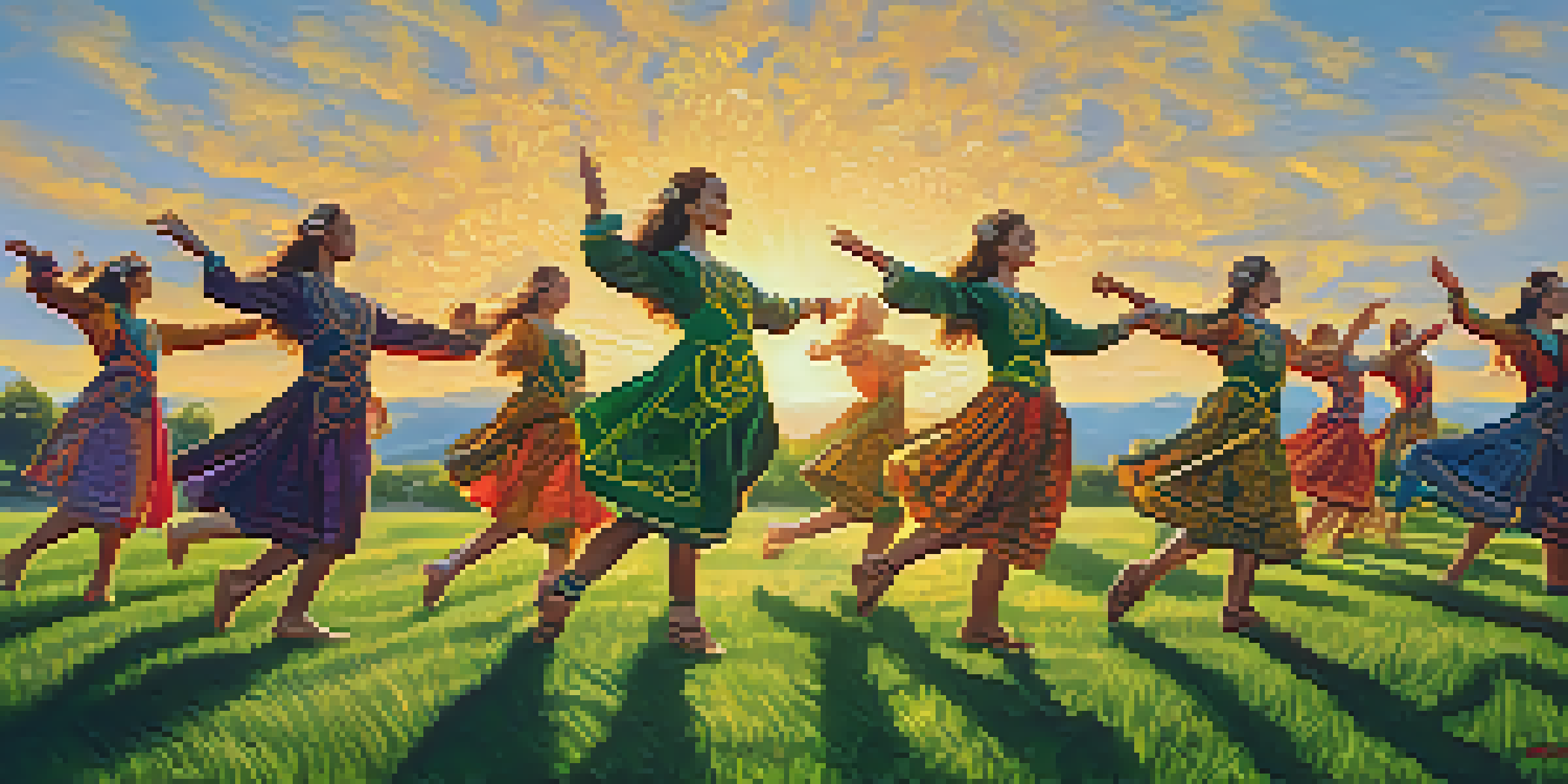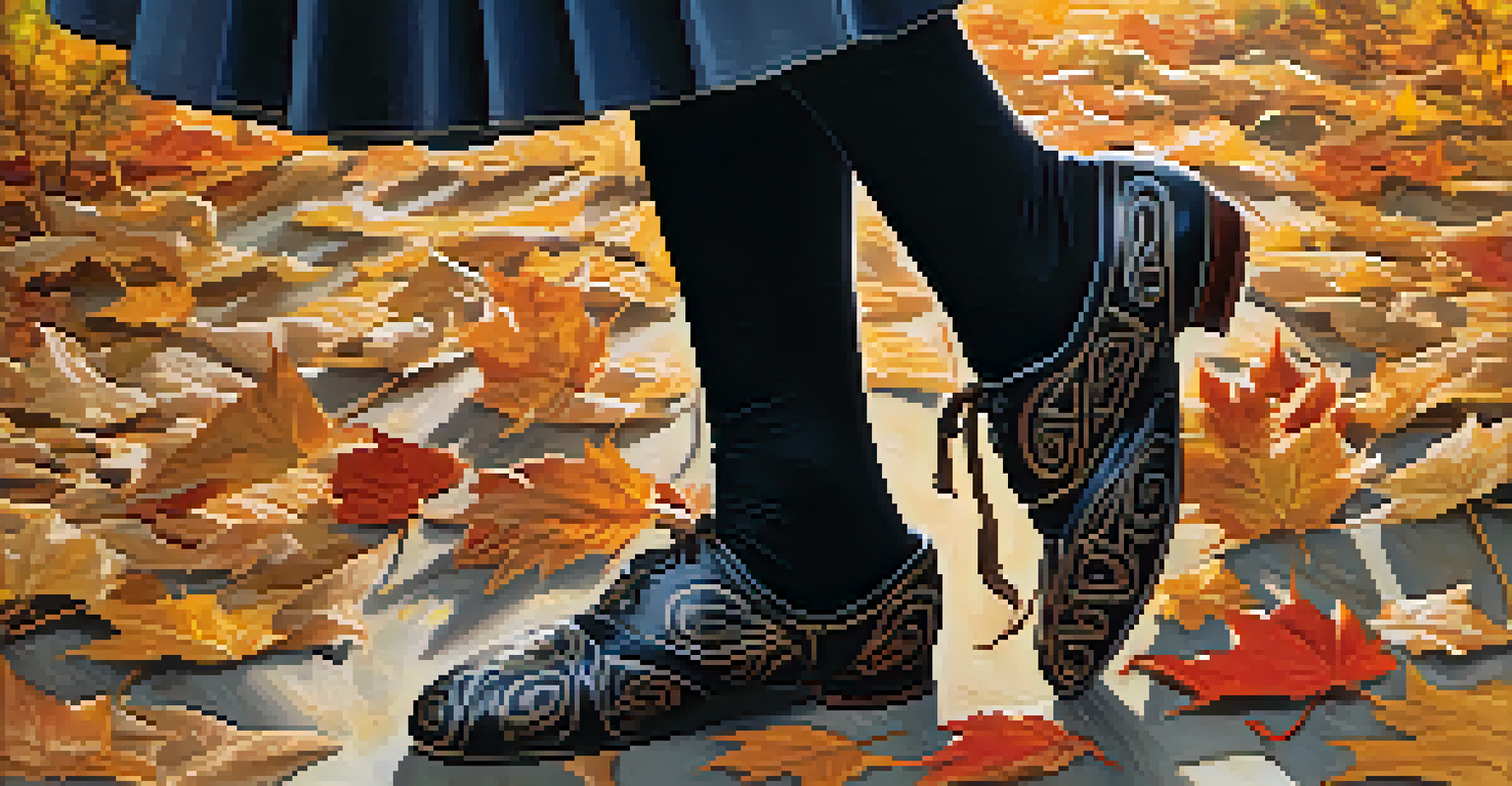Celtic Dance and Its Connection to Pagan Rituals

Celtic Dance: A Cultural Treasure of the Celts
Celtic dance is more than just a lively performance; it's a vibrant expression of cultural identity. Originating from the ancient Celtic tribes, these dances are steeped in tradition and are often performed at festivals and gatherings. The rhythmic footwork and energetic movements reflect the rich history and community spirit of the Celts, serving as a way to celebrate life and unity.
Dance is the hidden language of the soul.
In these dances, you can often see the influence of the natural world, with movements mimicking the flow of rivers or the sway of trees. This connection to nature plays a vital role in understanding the significance of Celtic dance within the broader context of Celtic spirituality. Each step is not just a movement; it embodies stories and beliefs passed down through generations.
Celtic dance is a living tradition, continuously evolving while honoring its roots. Today, it remains a popular form of expression, captivating audiences worldwide. This vibrant art form showcases the enduring legacy of Celtic culture and its ability to adapt while staying true to its foundational elements.
The Historical Roots of Pagan Rituals
Pagan rituals are often tied to nature, celebrating the cycles of the earth, seasons, and celestial events. These rituals were integral to the lives of the Celts, influencing their agricultural practices, festivals, and even their dances. The connection between these rituals and dance is profound, as many dances were performed to honor deities or mark significant events in the agricultural calendar.

For instance, dances during the Beltane festival celebrated the arrival of spring and fertility, often involving participants jumping over bonfires. Such practices were believed to bring good fortune and blessings for the upcoming season. By incorporating these ancient customs into dance, the Celts created a dynamic interplay between spirituality and artistry.
Celtic Dance Reflects Cultural Identity
Celtic dance is a vibrant expression of cultural identity, steeped in tradition and often performed at festivals to celebrate unity and community.
Understanding these historical roots enriches our appreciation for Celtic dance. The movements are not merely entertainment; they are imbued with meaning, reflecting the Celts' reverence for the earth and its cycles. This historical perspective allows us to see how dance served as a bridge between the physical and spiritual worlds.
The Role of Dance in Celtic Festivals
Celtic festivals are vibrant celebrations where dance plays a central role. Events like Lughnasadh and Samhain are not just social gatherings; they are steeped in tradition and spiritual significance. During these festivals, dance is used as a form of storytelling, conveying myths and legends that define Celtic culture.
The dance is a poem of which each movement is a word.
At these gatherings, people often dress in traditional attire, creating a visual spectacle that enhances the experience. The communal aspect of dance fosters a sense of belonging and unity, allowing participants to connect with their heritage and with each other. This shared experience transforms the dance floor into a sacred space where history and culture come alive.
Moreover, the rhythm of the music and the energy of the dancers can evoke a sense of transcendence, making it a spiritual experience as well. As participants engage in the dance, they may feel a connection to their ancestors, continuing a legacy that spans centuries. This interplay between celebration, spirituality, and community is what makes Celtic festivals so special.
Symbolism in Celtic Dance Movements
Every movement in Celtic dance carries symbolism, often reflecting the natural world and spiritual beliefs. For example, the circular formations in many dances symbolize unity and eternity, embodying the cyclical nature of life. Similarly, movements that mimic animals or elements of nature highlight the Celts' deep respect for their environment.
These symbolic gestures are not random; they are steeped in cultural significance. The dancers often tell a story or convey a message through their movements, allowing spectators to engage with the narrative on multiple levels. This connection between dance and storytelling creates a rich tapestry of meaning that resonates across generations.
Dance Connects to Spiritual Practices
The spiritual significance of Celtic dance lies in its ability to connect participants to divine forces, making each movement a form of worship and reverence.
Additionally, the repetitive patterns in Celtic dance can evoke a trance-like state, drawing participants and audiences alike into a deeper, more meditative experience. This trance can facilitate a connection to the spiritual realm, echoing the ancient practices of the Celts. Thus, every dance is a profound journey that intertwines movement, meaning, and memory.
Celtic Dance and Its Spiritual Significance
The spiritual significance of Celtic dance is deeply rooted in the belief that movement can connect us to the divine. For the Celts, dance was a way to honor the gods and the natural forces that shaped their world. The integration of rhythm, music, and movement created a sacred experience, transforming the act of dancing into a form of worship.
During rituals, specific dances were performed to invoke blessings or protection, reinforcing the idea that dance is a powerful conduit for spiritual expression. Participants often felt a heightened sense of awareness and connection to their surroundings, blurring the lines between the physical and spiritual realms. This connection is what made dance a fundamental aspect of their religious practices.
Today, many modern practitioners of Celtic dance still embrace this spiritual aspect, using dance as a form of meditation and connection to their heritage. Whether in a formal setting or at a community gathering, the dance becomes a celebration of life, nature, and the divine. This enduring legacy demonstrates how Celtic dance continues to inspire and uplift the spirit.
Modern Interpretations of Celtic Dance
As time has progressed, Celtic dance has evolved while maintaining its cultural roots. Contemporary interpretations often blend traditional forms with modern styles, creating a rich fusion that appeals to a broader audience. Whether it's through competitive performances or theatrical productions, these modern adaptations showcase the versatility and dynamism of Celtic dance.
However, despite these innovations, the essence of Celtic dance remains intact. Dancers still honor the foundational elements of rhythm, community, and storytelling, ensuring that the spirit of the ancient traditions persists. Many dance groups and schools focus on preserving the authenticity of traditional styles while also encouraging creativity and personal expression.
Modern Adaptations Preserve Tradition
Contemporary interpretations of Celtic dance blend traditional forms with modern styles, ensuring the art form remains relevant while honoring its rich heritage.
This blend of old and new not only keeps the tradition alive but also introduces it to new generations. As more people engage with Celtic dance, they contribute to its evolution, ensuring that it remains a living, breathing art form. This ongoing journey reflects the resilience of Celtic culture amidst changing times.
The Future of Celtic Dance and Its Cultural Legacy
The future of Celtic dance looks promising as interest in its cultural heritage continues to grow. With the rise of social media and global connectivity, more people are discovering and participating in Celtic dance. This newfound enthusiasm helps to keep the tradition alive while also allowing it to adapt to contemporary contexts.
Moreover, workshops and festivals dedicated to Celtic dance are popping up around the world, fostering a sense of community among enthusiasts. These gatherings serve as a platform for sharing knowledge, skills, and stories, ensuring that the cultural legacy is passed down to future generations. As new dancers engage with the tradition, they become custodians of its rich history.

Ultimately, the preservation and evolution of Celtic dance will depend on the passion and dedication of its practitioners. By embracing both tradition and innovation, the future of Celtic dance can thrive, continuing to inspire and connect people with their heritage. This vibrant art form is not just a relic of the past; it is a living testament to the enduring spirit of the Celts.